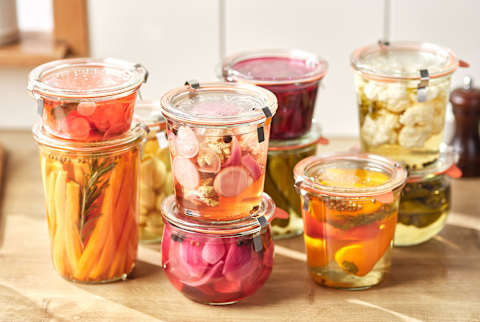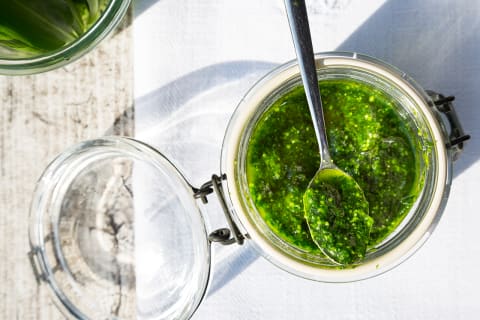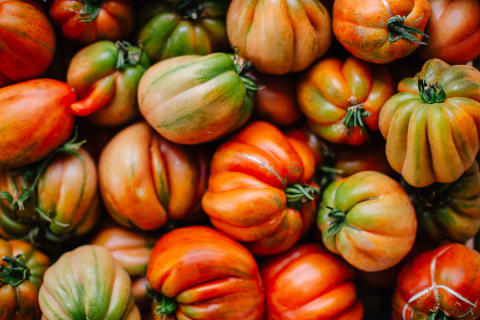25 Genius Ways To Store Summer Produce So It Lasts All Year Long
Here's how expert gardeners put every last morsel to delicious use.


mbg Contributor
Emma Loewe is the former Sustainability and Health Director at mindbodygreen. She is the author of "Return to Nature: The New Science of How Natural Landscapes Restore Us" and the co-author of "The Spirit Almanac: A Modern Guide To Ancient Self Care." Emma received her B.A. in Environmental Science & Policy with a specialty in environmental communications from Duke University. In addition to penning over 1,500 mbg articles on topics from the water crisis in California to the rise of urban beekeeping, her work has appeared on Grist, Bloomberg News, Bustle, and Forbes.
Image by Martí Sans / Stocksy September 08, 2024 We carefully vet all products and services featured on mindbodygreen using our Our selections are never influenced by the commissions earned from our links. With late summer come and gone, home growers everywhere are left with the season's bounty on their hands and on their countertops. In the name of putting every last morsel to delicious use, we asked seasoned gardeners how they prepare and store their fruit, produce, and herbs to last through the fall and winter. Here are 25 of their favorite tips, tricks, and recipes for locking in that farm-fresh flavor:
Berries
Paul Anderton, one of the homesteaders behind Two Dirty Boys, freezes his fresh blueberries with a little coconut oil to prevent clumping. They're ready for highly sippable morning smoothies from there.
Epic Gardening founder Kevin Espiritu prefers to mash up his summer fruits—apricots, peaches, plums, etc.—into a sweet jam to spread through the winter. If you go this route, he says to "be sure to follow a safe, thoroughly tested recipe to avoid the risk of any bacteria-borne illnesses," adding that he trusts those that come from the Ball canning books and the National Center for Food Preservation.

Image by Martí Sans / Stocksy
To dry out any fruit, try this hack from Espiritu: Cut the fruit into strips if needed, then drop the strips in a bowl of cold water with a squeeze of lemon juice (to prevent browning), lay them on a baking sheet in a single layer, and place them in a dehydrator or oven on the lowest setting until completely dry. "This also works for thick leaves of kale and succulent summer melons like cantaloupe or honeydew," he adds.
Broccoli
You can freeze your broccoli until you're ready to cook with it, but Espiritu recommends quickly blanching it in boiling water first to lock in its vibrant color. Then, pat dry before popping in the freezer.
Cabbage
Anderton loves to turn his cabbage into a big batch of gut-healthy sauerkraut, while Espiritu is partial to combining his with carrots, daikon radishes, and pickling cucumbers for a quick kimchi. The probiotic possibilities are endless.
Green beans
To preserve green beans for a veggie-packed soup or satisfying salad, organic gardener Allison Vallin Kostovick of Finch & Folly farm likes to snap off their tips, blanch them in boiling water for 30 seconds, and immerse them in an ice bath for a few seconds. After drying them, she'll spread them across a baking sheet in a single layer and freeze.
Once hardened, you can bag them up and keep them in the freezer for later. "This way, you can grab as many or as few as you want," she says, rather than be stuck with one giant chunk of frozen beans.
Herbs
Herbs can be prolific, and Kostovick likes to pick a big batch of them in the fall to hang out to dry in loose bunches out of the sun, and away from heat.
Tender herbs that lose flavor when dried—chives, dill, basil, etc.—are frozen in her household. She'll chop them up, place them in ice cube trays, cover them with a bit of olive oil (you could use water too), and freeze them for pre-portioned, ready-to-cook herb bundles.
Basil can be whipped into a quick pesto. Nancy Lawson, naturalist and author of The Humane Gardener: Nurturing a Backyard Habitat for Wildlife, likes to freeze hers in small containers she can cook with throughout the winter. She'll also make backup pesto reserves out of garlic mustard, a weed! "Garlic mustard is not a good plant to leave because it crowds out wildlife-friendly plants, so all that pulling and weeding is not in vain if you can find a way to use it! It is very yummy if you use a recipe that cuts the bitterness." (Hers uses maple syrup.)

Image by Westend61 / Getty
Sesame leaves, or Korean perilla leaves, can be preserved for an umami-packed treat. Urban gardener Marie Viljoen of 66 Square Feet (Plus) likes to clip the leaves off the stalks, then rinse, dry, and stack them on top of one another in groups of 10. "Starting at the stem-end of the stack," she explains, "roll the leaves into a cigar-shape, place in a clean glass jar, and cover with good soy sauce (I like Ohsawa nama shoyu).
To use, remove a leaf or leaves and slice finely to add to salads, steamed rice, egg dishes, roasted vegetables, fish dishes, grilled mushrooms, and meats. Basically everything!"
Finally, Kostovick will always save some mint from her herbal haul to turn into an extract for holiday baking. Here's the quick recipe she uses:
Leafy greens
While delicate leafy greens may seem destined to go bad quickly, Espiritu says you can actually dehydrate these as well, as long as you don't use heat. "Either use a dehydrator on an air-only setting or attach two clean air filters to a clean box fan with your greens pressed flat between the filters," he advises. "To use them later, crumble them into smoothies or add to soups."
Peppers
Up to your neck in hot peppers? You can take a nod from Jasmine Jefferson, the founder of Black Girls With Gardens, and turn them into a hot sauce, or follow Murphy's lead and give them a quick pickle.
Bell peppers and jalapeños can be cut into slices, arranged on a baking sheet, flash-frozen, and then placed in a container. "That way it's easy to just take a few slices out when making salsa or a stir fry," says Lawson.
Potatoes
Potatoes and alliums like garlic or onions can be stored in a dry, cool, and dark location until you're ready to use them. Espiritu cautions that light and moisture can cause them to sprout or turn green. "Check them regularly to make sure they remain firm," he recommends, "and remove any that are spoiling."
Squash
When Jefferson collects her squash, she'll leave a week's worth out on the counter for easy access and slice up the rest to freeze for later use. From there, they can go into soups, curries, and even pancakes.
Espiritu likes to cook his squash before storing it, to impart it with a richer, smoky flavor: "Remove the seeds and the hard rind, dust it with a little salt and black pepper, and smoke the squash whole until it's tender and delicious. Cut it into cubes, lay it on a baking sheet, and freeze it. When you're ready to use it, either heat and eat just as it is, or turn it into the most amazing smoked squash soup you'll ever taste." Sold.
Tomatoes
Once homegrown tomatoes reach peak flavor, Kostovick doesn't like to mess with them too much: She'll just wash, dry, and freeze them whole, then thaw before using.
For an easy way to use up extra tomatoes that are on their way out, Lawson likes to turn them into the base for a sauce that can be whipped up at a later date. "I used to go through the trouble of processing them through a tomato strainer and then freezing that sauce, but then I realized that's a lot of work when I could just be using whole tomatoes, cooking them a bit, and then freezing the end result of that," she explains. "It's so easy to take it out a few months later, add some peppers, onions, and herbs, and have a quick sauce that way!"

Image by Ewa Fournier le Ray / Unsplash
Anderton opts to give his a low-and-slow roast in the oven for a sun-dried tomato effect. "This is genuinely so delicious and a brilliant way to deal with the late summer glut," he raves.
Watermelon
Espiritu likes to eternalize the seasonal staple by pickling the rinds and blending the flesh into watermelon juice that can be frozen for summer cocktails and mocktails on demand.
Zucchini
Finally, zucchini can be shred in a food processor and left to sit in a mesh strainer for 20 minutes to expel any extra moisture. From there, Kostovick measures out 1-cup portions to freeze in bags for future soups and stews.

 Konoly
Konoly 































